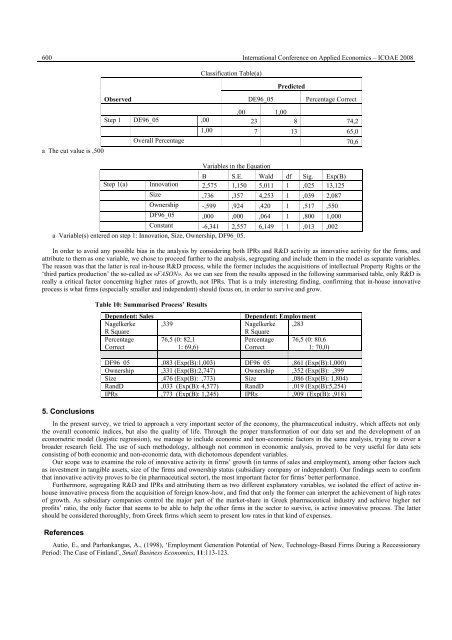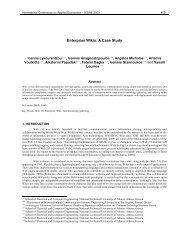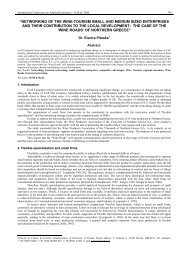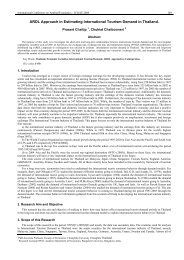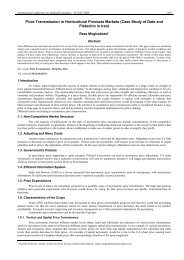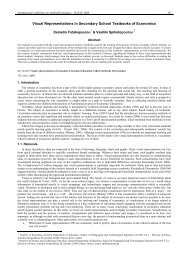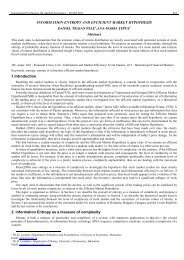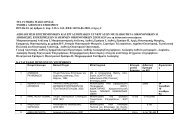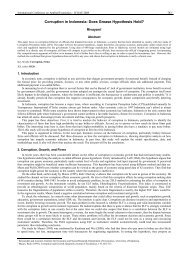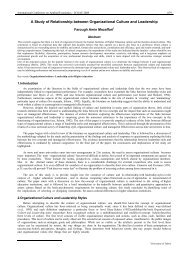The Impact of Innovative Activity in Economic Performance: An ...
The Impact of Innovative Activity in Economic Performance: An ...
The Impact of Innovative Activity in Economic Performance: An ...
You also want an ePaper? Increase the reach of your titles
YUMPU automatically turns print PDFs into web optimized ePapers that Google loves.
600 International Conference on Applied <strong>Economic</strong>s – ICOAE 2008<br />
a <strong>The</strong> cut value is ,500<br />
Observed<br />
Classification Table(a)<br />
Predicted<br />
DE96_05 Percentage Correct<br />
,00 1,00<br />
Step 1 DE96_05 ,00 23 8 74,2<br />
1,00 7 13 65,0<br />
Overall Percentage 70,6<br />
Variables <strong>in</strong> the Equation<br />
B S.E. Wald df Sig. Exp(B)<br />
Step 1(a) Innovation 2,575 1,150 5,011 1 ,025 13,125<br />
Size ,736 ,357 4,253 1 ,039 2,087<br />
Ownership -,599 ,924 ,420 1 ,517 ,550<br />
DF96_05 ,000 ,000 ,064 1 ,800 1,000<br />
Constant -6,341 2,557 6,149 1 ,013 ,002<br />
a Variable(s) entered on step 1: Innovation, Size, Ownership, DF96_05.<br />
In order to avoid any possible bias <strong>in</strong> the analysis by consider<strong>in</strong>g both IPRs and R&D activity as <strong>in</strong>novative activity for the firms, and<br />
attribute to them as one variable, we chose to proceed further to the analysis, segregat<strong>in</strong>g and <strong>in</strong>clude them <strong>in</strong> the model as separate variables.<br />
<strong>The</strong> reason was that the latter is real <strong>in</strong>-house R&D process, while the former <strong>in</strong>cludes the acquisitions <strong>of</strong> <strong>in</strong>tellectual Property Rights or the<br />
‘third parties production’ the so-called as «FASON». As we can see from the results apposed <strong>in</strong> the follow<strong>in</strong>g summarised table, only R&D is<br />
really a critical factor concern<strong>in</strong>g higher rates <strong>of</strong> growth, not IPRs. That is a truly <strong>in</strong>terest<strong>in</strong>g f<strong>in</strong>d<strong>in</strong>g, confirm<strong>in</strong>g that <strong>in</strong>-house <strong>in</strong>novative<br />
process is what firms (especially smaller and <strong>in</strong>dependent) should focus on, <strong>in</strong> order to survive and grow.<br />
5. Conclusions<br />
Table 10: Summarised Process’ Results<br />
Dependent: Sales Dependent: Employment<br />
Nagelkerke ,339 Nagelkerke ,283<br />
R Square<br />
R Square<br />
Percentage 76,5 (0: 82,1<br />
Percentage 76,5 (0: 80,6<br />
Correct<br />
1: 69,6)<br />
Correct<br />
1: 70,0)<br />
DF96_05 ,083 (Exp(B):1,003) DF96_05 ,861 (Exp(B):1,000)<br />
Ownership ,331 (Exp(B):2,747) Ownership ,352 (Exp(B): ,399<br />
Size ,476 (Exp(B): ,773) Size ,086 (Exp(B): 1,804)<br />
RandD ,033 (Exp(B): 4,577) RandD ,019 (Exp(B):5,254)<br />
IPRs ,773 (Exp(B): 1,245) IPRs ,909 (Exp(B): ,918)<br />
In the present survey, we tried to approach a very important sector <strong>of</strong> the economy, the pharmaceutical <strong>in</strong>dustry, which affects not only<br />
the overall economic <strong>in</strong>dices, but also the quality <strong>of</strong> life. Through the proper transformation <strong>of</strong> our data set and the development <strong>of</strong> an<br />
econometric model (logistic regression), we manage to <strong>in</strong>clude economic and non-economic factors <strong>in</strong> the same analysis, try<strong>in</strong>g to cover a<br />
broader research field. <strong>The</strong> use <strong>of</strong> such methodology, although not common <strong>in</strong> economic analysis, proved to be very useful for data sets<br />
consist<strong>in</strong>g <strong>of</strong> both economic and non-economic data, with dichotomous dependent variables.<br />
Our scope was to exam<strong>in</strong>e the role <strong>of</strong> <strong>in</strong>novative activity <strong>in</strong> firms’ growth (<strong>in</strong> terms <strong>of</strong> sales and employment), among other factors such<br />
as <strong>in</strong>vestment <strong>in</strong> tangible assets, size <strong>of</strong> the firms and ownership status (subsidiary company or <strong>in</strong>dependent). Our f<strong>in</strong>d<strong>in</strong>gs seem to confirm<br />
that <strong>in</strong>novative activity proves to be (<strong>in</strong> pharmaceutical sector), the most important factor for firms’ better performance.<br />
Furthermore, segregat<strong>in</strong>g R&D and IPRs and attribut<strong>in</strong>g them as two different explanatory variables, we isolated the effect <strong>of</strong> active <strong>in</strong>house<br />
<strong>in</strong>novative process from the acquisition <strong>of</strong> foreign know-how, and f<strong>in</strong>d that only the former can <strong>in</strong>terpret the achievement <strong>of</strong> high rates<br />
<strong>of</strong> growth. As subsidiary companies control the major part <strong>of</strong> the market-share <strong>in</strong> Greek pharmaceutical <strong>in</strong>dustry and achieve higher net<br />
pr<strong>of</strong>its’ ratio, the only factor that seems to be able to help the other firms <strong>in</strong> the sector to survive, is active <strong>in</strong>novative process. <strong>The</strong> latter<br />
should be considered thoroughly, from Greek firms which seem to present low rates <strong>in</strong> that k<strong>in</strong>d <strong>of</strong> expenses.<br />
References<br />
Autio, E., and Parhankangas, A., (1998), ‘Employment Generation Potential <strong>of</strong> New, Technology-Based Firms Dur<strong>in</strong>g a Reccessionary<br />
Period: <strong>The</strong> Case <strong>of</strong> F<strong>in</strong>land’, Small Bus<strong>in</strong>ess <strong>Economic</strong>s, 11:113-123.


